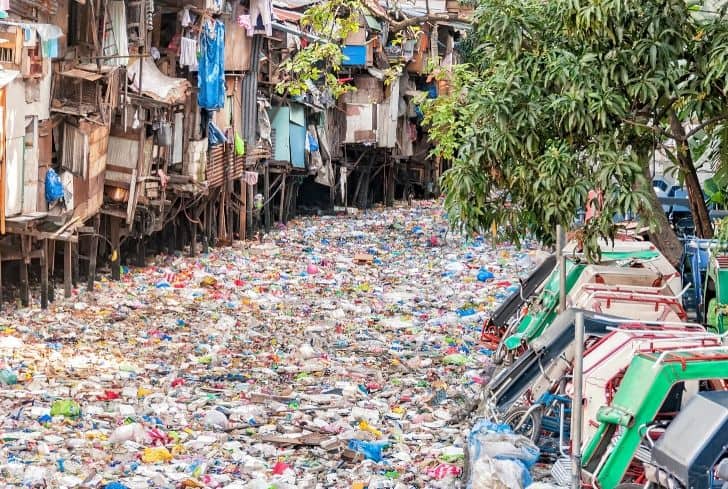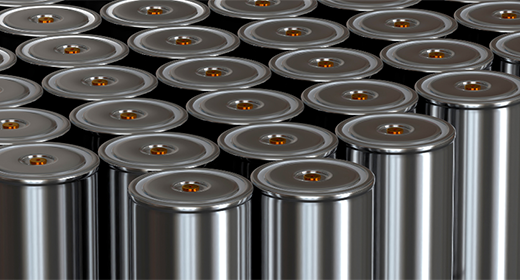by Rinkesh: Every day synthetic, toxic chemicals are released into the environment…
It affects our water, land and air. Water is our most vital resource but also our most threatened. Without water, there is no life. Our land is where we live and thrive. The air is what we breathe; what travels through the air is what we inhale. As it ultimately affects the future of our planet and us, it is considered to be a global threat at a huge cost to the environment.
The toxic pollution problems discussed below impact more to the people who live near to the sources of pollution. These pollutants may cause serious health effects such as birth defects, development disorders, respiratory problems, cancer and, in some cases, can lead to death. Apart from this, it can also have an adverse effect on wildlife and the environment.
Here is a list of the Top 13+ Toxic Pollution Problems our world faces today, in no particular order.
1. Lead-Acid Battery Recycling
These rechargeable batteries are composed of lead plates and sulfuric acid in a plastic case. The battery recycling business is a very large industry. Although it aims to reduce the number of disposable batteries as solid waste, batteries contain a high number of toxic metals and chemicals like lead oxide that lead to the pollution of our water and contamination of soil.
2. Mercury and Lead Pollution from Mining
More than two million people globally are affected by mining and ore processing. These mining sites provide various minerals and metals to produce a variety of products and minerals. The most hazardous chemicals that are found near these sites are lead, chromium, asbestos, arsenic, cadmium and mercury.
3. Coal Mining (Sulfur Dioxide and Mercury Pollution)
Though it’s often overlooked, the high levels of mercury in the air are a serious threat to human health. Originating from power plants fired by coal, many of which are located very close to large urban areas and cities in America. It can also travel exceptionally far (as in thousands of miles) through the air.
Mercury is extremely damaging to human health as it severely damages the brain and nervous system when inhaled or made contact with. It is also estimated that a high percentage of pregnant women in America are affected by high mercury levels that affect a foetus’ brain development. All in all, mercury is one of the most deadly toxic pollutants in the air.
Not only is Sulfur Dioxide (SO2) a substantial pollutant in our air and a direct result of coal power plants, it is also one of the causes of some serious health problems. It can be a root cause of lung cancer, asthma, emphysema, and bronchitis. As a result, thousands of people are tragically hospitalized or die each year. It is seriously toxic to human health. SO2 originates primarily from fossil fuel combustion at power plants and coal power plants.
4. Artisanal Gold Mining (Mercury Pollution)
The production process of retrieving gold from mined ores releases more mercury than any other global sector. The mining process is usually done in the open air, putting people living nearby at risk either through contaminated water or soil. The vaporized mercury is a potent neurotoxic element that causes developmental disorders and affects the central nervous system.
5. Lead Smelting
Each year millions of people are affected by the toxic chemicals, primarily iron, limestone, pyrite and zinc that are released into the air by the dozens of lead smelting sites around the world. Lead smelting uses furnaces and other chemical agents to remove impurity from lead ores. Lead smelting puts approximately 2.5 million people at risk at 70 polluted lead smelting sites worldwide, according to Blacksmith Institute.
6. Pesticides Pollution from Agriculture and Storage
Pesticides are substances necessary for agriculture to destroy targeted pests. Approximately 2 million metric tons of pesticides are used annually in fields. As a result, millions of tons of pesticides are dumped every year on our fields. Unfortunately, the health effects pesticides have on us are disastrous, from simple skin irritation to hurting to the nervous system to even causing cancer.
Apart from this, stockpiles of old and outdated pesticides add to the trouble. Most of the farmers are illiterate and use expired products. An estimated six to nine million metric tonnes of such pesticides are improperly stored.
7. Arsenic in Ground Water
Arsenic in Groundwater is a naturally occurring pollution problem that affects some 750,000 people, mostly in South Asia. Contaminated groundwater is still used by many people, which can lead to cancer, blood vessel damage, abnormal heartbeat and some other ill effects.
8. Industrial Waste Water
Wastewater is water that has been harmfully affected by outside influence, and that flows from an open drain. Wastewater may or may not be affected by any of the following, but certainly not limited to, batteries, smelting, toxins, organic particles, pathogens, methane and carbon dioxide. This water ends up in the environment where it is much more harmful to humans than irrigation water.

9. Chromium Pollution (Dye Industry)
Believe it or not, the dye industry actually contains numerous health hazards. Dye is used to add color to material, but the additions they have to pollution are more than noticeable. While chromium, which is used in dye, is critical to the human diet and generally speaking, causes no damage to the human body, Cr IV Chromium is dangerous and highly toxic, enough to cause death in humans.
10. Chromium Pollution (Tanneries)
Chromium is primarily used to turn animal hides into leather for consumers, in places called tanneries, which are primarily centered in South-East Asia. Such tanneries are still operating with little control and produce daily 7.7 million liters of wastewater and 88 million tons of solid waste. Again, Cr IV is dangerous and can cause health problems as respiratory and heart failure and cancer in the brain and kidneys.
11. Lead Pollution from Industrial Estate or Industrial Parks
Industrial Estates are planned, zoned areas that are set aside for a variety of industries, offices, and production. These areas are also known as industrial parks. Industrial parks contain a large variety of businesses ranging from food production to heavy metal smelting.
Typical industries that produce high amounts of lead and that may be found in industrial estates include lead-acid battery production and recycling (which accounts for more than two-thirds of global lead use); lead smelting and casting; manufacturing of lead-glass and lead compounds; manufacturing of pigments, paint, and ceramic glazes; and recycling of e-waste that contains Cathode Ray Tubes.
Unfortunately, in many low- and middle-income countries, industrial estates have little to no waste treatment and disposal infrastructure, and they are often located near populated areas. In the case of an industrial estate that has no pollution control mechanisms, lead can be released into the surrounding air, soil, water, and food.
The health effects of exposure to lead can be both acute and chronic, and the problems caused by lead poisoning are reduced IQ, anemia, neurological damage, physical growth impairments, nerve disorders, pain and aching in muscles and bones, memory loss, kidney disorders, retardation, tiredness and headaches, and lead colic, which impacts the abdomen. Severe exposure to high concentrations of lead can lead to dire health risks, including seizures, delirium, coma, and in some cases, death.
12. Mercury Pollution from Chemical Manufacturing
Mercury has been used in chemical manufacturing processes for many years as a useful catalyst and reagent, helping in the production of many different substances. Mercury is most commonly used in the manufacturing of pharmaceuticals, cleaning agents, dyes, explosives, and preservatives. Mercury is also used in a variety of devices at some chemical manufacturing facilities, such as thermometers.
Mercury can be released during chemical manufacturing much in the same ways as chromium, and that is through effluent and emissions. If not properly treated or contained, wastewater from washing spills and cooling in addition to breaking of thermometers or other products containing elemental mercury, like fluorescent light bulbs, can all lead to mercury contamination of ground and surface water systems. Mercury can also be released through emissions from chemical heating processes.
Mercury pollution from chemical manufacturing can be very dangerous for workers who may come into direct contact with liquid or vapor mercury, and the toxin can also enter drinking water systems, soil, and the food chain.
Countries with poor infrastructure and effluent treatment facilities are particularly at risk from wastewater contamination, and Blacksmith estimates that mercury from chemical manufacturing impacts many people in Eastern Europe, Northern Eurasia, and Central Asia
13. Cadmium Pollution Mining and Ore Processing
Cadmium is a naturally occurring element in the earth’s crust that commonly occurs as an oxide, sulfide, or chloride compound and is used in a variety of different industries, including metal plating and for plastic, pigment, and battery production.
Cadmium pollution can also be created by the mining of coal, as one study found that there were high levels of cadmium in blood (>0.5 μg/dL) in 85 % of children under the age of six who lived near a coal mine in Turkey.
Cadmium can enter the environment in many different ways; smelting and ore processing of zinc is one of the leading anthropogenic causes of cadmium pollution. As cadmium is present in the ores of commonly mined elements, it can be transferred into the environment through waste rock and ore processing tailings. If mines contain smelters at their ore processing facilities, cadmium can also be released into the air during the heating of ore or can remain in the waste slag created by the smelting and refining process.
Once airborne, cadmium can travel easily as dust or vapor, and often contaminates soil and food when it settles back to the ground. The ingestion of food contaminated with cadmium is a fairly common route of exposure. Cadmium compounds in mining waste rock and tailings can leach into water and soil and contaminate drinking wells and water sources used for bathing and irrigation. Workers in the mines can be exposed to high levels of cadmium dust and vapor when proper precautions are not taken.
Cadmium is a very hazardous material that is a known human carcinogen. Inhalation and oral exposure to cadmium can cause chronic lung and kidney disorders, and in extreme cases, exposure may cause cancer.
14. Cyanide Pollution from Mining and Ore Processing
Cyanide is not formed in the earth’s crust but is instead created by various types of algae, bacteria, fungi, and plants. Cyanide contamination is commonly associated with the mining of metals, particularly gold since it can bond with the desired metals and help isolate them from their ore.
Cyanide use is normally part of the ore processing phase, and the most common methods are vat-leaching and heap-leaching. Vat-leaching consists of mixing crushed ore with a cyanide compound in a vat where it will form a new compound with the metal and can aid in isolating desired material from the unwanted waste rock.
The leaching processes, if done improperly or without the necessary oversight, can create large amounts of wastewater that often contains trace amounts of cyanide. The toxin can also remain in the tailings left behind from the ore processing, where it can leach into soil and groundwater systems, or can enter the air as dust.
Cyanide is a highly toxic substance, and acute exposure can lead to heart and brain problems, and in some cases, can cause death. Chronic exposure to cyanide through inhalation, ingestion, or dermal contact can cause problems with breathing, headaches, thyroid enlargement, chest pain, seizures, and skin irritation or sores.










































